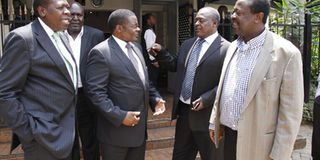Ambitious Luhya plan to register 6m voters no walk in the park

Former justice minister Eugene Wamalwa, former speaker of the National Assembly Kenneth Marende, Cyrus Jirongo and former deputy prime Minister Musalia Mudavadi at Mayfair Hotel on August 28, 2014 where they met to forge unity among Western leaders. FILE | JEFF ANGOTE |
What you need to know:
- “I have bought motorbikes and distributed them in a number of constituencies to help sensitise our communities to prepare early and register as voters so that we can chart our destiny for 2017,” Mr Wetang’ula told the Sunday Nation in an interview on Friday.
- “It’s unfortunate that the Luhya, who are the second-largest community in the country, have failed to take advantage of their numbers to emerge as a political power house,” Mr Wekesa said.
- Lugari MP Ayub Savula, who is among those championing the initiative, said the MPs would tour the coastal region on January 31 before visiting other counties to drum up support for their crusade.
- Vihiga’s population is projected to rise from 554,622 to 585,981 with 266,775 being eligible voters, while Busia’s could increase from 743,946 in 2009 to 864,342 and Bungoma’s expected to hit the 1,606,603 mark compared to 1,375,063 in 2009.
Because of their large numbers, the Luhya community can influence the outcome of any presidential election. But they hardly ever do, largely because of voter apathy and failure to vote as a bloc.
According to figures from the western region office of the Kenya National Bureau of Statistics, the population in the four counties of Kakamega, Vihiga, Busia and Bungoma stood at 4.3 million in 2009, making them the second-largest segment of Kenya’s population after the Kikuyu.
The Luhya are also represented in other counties, especially neighbouring Trans Nzoia.
Politicians from the area reckon that a combined vote and a huge voter turnout would dramatically alter Kenya’s political landscape.
To assert their weight in the next elections, leaders have launched a voter registration campaign in addition to forming a union of the Luhya, Teso and Sabaot (Lutesa), modelled around the Gikuyu Embu Meru Association (Gema) of Mt Kenya.
Politicians who spoke to the Sunday Nation agree that a high voter registration would enable the region influence the outcome of the election.
But the enduring question remains: Is such a feat feasible?
Senate Minority Leader Moses Wetang’ula thinks the campaign could easily register between 4.5 and five million voters.
He said the Luhya had attractive numbers to play a meaningful role in the country’s political leadership.
The senator says he has already rolled out the campaign in his Bungoma home turf.
CHART OUR DESTINY
“I have bought motorbikes and distributed them in a number of constituencies to help sensitise our communities to prepare early and register as voters so that we can chart our destiny for 2017,” Mr Wetang’ula told the Sunday Nation in an interview on Friday.
He said the Lutesa initiative should bring on board politicians, the clergy, administration officials, community organisations and youth groups.
“The aim is to change the situation where the majority have constantly remained subordinate in the political contest for the presidency despite the community’s numerical strength,” said Mr Wetang’ula.
However, the Bungoma senator said the campaign should not be seen as a move to isolate the Luhya nation from the rest of Kenya. Former Cabinet minister Noah Wekesa says the biggest challenge is the failure by western Kenya residents to use their numerical strength in voting for one of their own in a presidential contest.
“It’s unfortunate that the Luhya, who are the second-largest community in the country, have failed to take advantage of their numbers to emerge as a political power house,” Mr Wekesa said.
A projection for 2014 indicates that Kakamega will have a population of 1,879,883 with 768,200 being eligible to vote.
Vihiga’s population is projected to rise from 554,622 to 585,981 with 266,775 being eligible voters, while Busia’s could increase from 743,946 in 2009 to 864,342 and Bungoma’s expected to hit the 1,606,603 mark compared to 1,375,063 in 2009.
A group of MPs behind the Lutesa initiative plan to take their campaign to the Coast.
Lugari MP Ayub Savula, who is among those championing the initiative, said the MPs would tour the coastal region on January 31 before visiting other counties to drum up support for their crusade.
“This time we (MPs) are focused on the bigger picture to unite our communities and strategise on how to clinch the presidency,” said Mr Savula.
However, Bungoma Governor Kenneth Lusaka said although the idea was good, the county chiefs from the region had not been involved.
But Mr Tom Mboya, Maseno University political science lecturer, says it is unlikely the campaign would register six million voters as targeted and mobilise the lot to turn out to vote.
Mr Mboya said ideological differences that have seen the Bukusu clan in the north work with the opposition and the clans in the south allied to government, would also determine the impact of the Lutesa as a political force.



